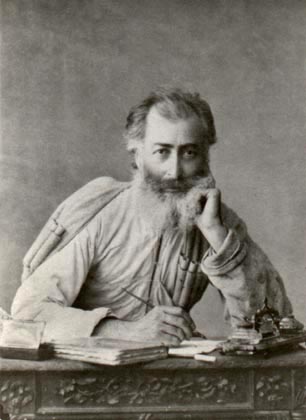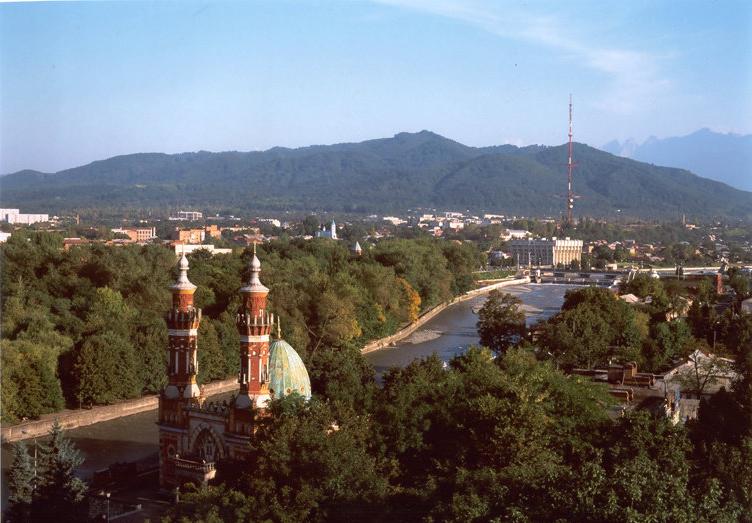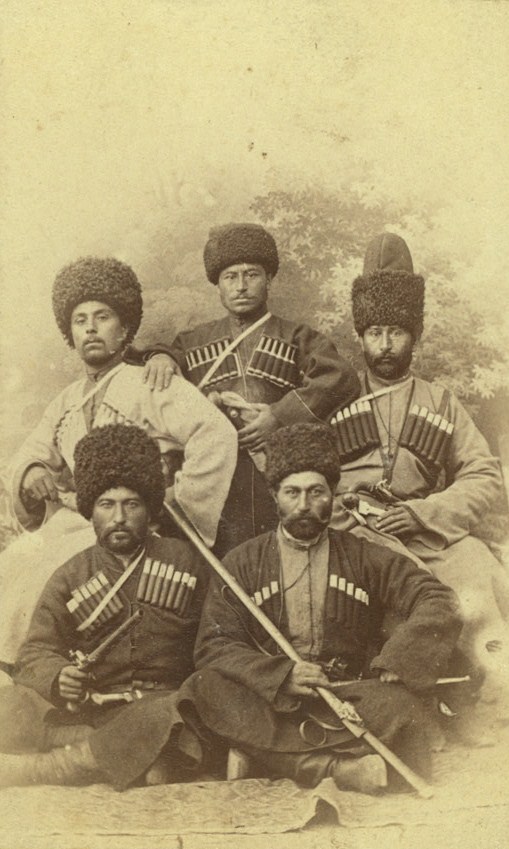|
Mount Kazbegi
Mount Kazbek or Mount Kazbegi is a dormant stratovolcano and one of the major mountains of the Caucasus, located on the Russian-Georgian border - in Russia's North Ossetia region and Georgia's Kazbegi District. At 5,034 m (16,515 ft) high, it is one of the highest peaks in Russia and the third-highest peak in Georgia (after Mount Shkhara and Janga). Kazbegi is also the second-highest volcanic summit in the Caucasus, after Mount Elbrus. The summit lies directly to the west of the town of Stepantsminda and is the most prominent geographic feature of the area. The name Kazbeg is disputed; some claims are it is named after a Circassian nobleman who lived on it, other claims are it is named after local nobleman Dimitri Chopikashvili (grand father of the Georgian writer Aleksandre Kazbegi) got the title of "Kazgeb" from Georgian king Erekle II. The word "Kazbek" means a "nobleman" in Kabardian language. The title appeared under Georgian king Rostom in the 17th century. The name of t ... [...More Info...] [...Related Items...] OR: [Wikipedia] [Google] [Baidu] |
Ultra-prominent Peak
An ultra-prominent peak, or Ultra for short, is a mountain summit with a topographic prominence of or more; it is also called a P1500. The prominence of a peak is the minimum height of climb to the summit on any route from a higher peak, or from sea level if there is no higher peak. There are approximately 1,524 such peaks on Earth. Some well-known peaks, such as the Matterhorn and Eiger, are not Ultras because they are connected to higher mountains by high cols and therefore do not achieve enough topographic prominence. The term "Ultra" originated with earth scientist Steve Fry, from his studies of the prominence of peaks in Washington in the 1980s. His original term was "ultra major mountain", referring to peaks with at least of prominence. Distribution Currently, 1,518 Ultras have been identified above sea level: 639 in Asia, 356 in North America, 209 in South America, 120 in Europe (including 12 in the Caucasus), 84 in Africa, 69 in Oceania, and 41 in Antarctica. Man ... [...More Info...] [...Related Items...] OR: [Wikipedia] [Google] [Baidu] |
Alexander Kazbegi
Alexander Kazbegi ( ka, ალექსანდრე ყაზბეგი, ) (1848–1893) was a Georgian writer, famous for his 1883 novel ''The Patricide''. Early life Kazbegi was born in Stepantsminda the great grandson of Kazibek Chopikashvili, a local feudal magnate who was in charge of collecting tolls on the Georgian Military Highway. Alexander Kazbegi studied in Tbilisi, Saint Petersburg and Moscow, but on returning home, decided to become a shepherd to experience the lives of the local people. He later worked as a journalist, and then became a novelist and playwright. In his later life, he suffered from insanity. After his death in Tbilisi, his coffin was carried across the Jvari Pass to his hometown of Kazbegi (now renamed Stepantsminda), which also preserves his childhood home as a museum in his honor. His most famous work, the novel ''The Patricide'' is about a heroic Caucasian bandit named Koba, who, much like Robin Hood, is a defender of the poor. Koba has n ... [...More Info...] [...Related Items...] OR: [Wikipedia] [Google] [Baidu] |
Earthquake
An earthquake (also known as a quake, tremor or temblor) is the shaking of the surface of the Earth resulting from a sudden release of energy in the Earth's lithosphere that creates seismic waves. Earthquakes can range in intensity, from those that are so weak that they cannot be felt, to those violent enough to propel objects and people into the air, damage critical infrastructure, and wreak destruction across entire cities. The seismic activity of an area is the frequency, type, and size of earthquakes experienced over a particular time period. The seismicity at a particular location in the Earth is the average rate of seismic energy release per unit volume. The word ''tremor'' is also used for Episodic tremor and slip, non-earthquake seismic rumbling. At the Earth's surface, earthquakes manifest themselves by shaking and displacing or disrupting the ground. When the epicenter of a large earthquake is located offshore, the seabed may be displaced sufficiently to cause ... [...More Info...] [...Related Items...] OR: [Wikipedia] [Google] [Baidu] |
Plate Tectonics
Plate tectonics (from the la, label=Late Latin, tectonicus, from the grc, τεκτονικός, lit=pertaining to building) is the generally accepted scientific theory that considers the Earth's lithosphere to comprise a number of large tectonic plates which have been slowly moving since about 3.4 billion years ago. The model builds on the concept of ''continental drift'', an idea developed during the first decades of the 20th century. Plate tectonics came to be generally accepted by geoscientists after seafloor spreading was validated in the mid to late 1960s. Earth's lithosphere, which is the rigid outermost shell of the planet (the crust and upper mantle), is broken into seven or eight major plates (depending on how they are defined) and many minor plates or "platelets". Where the plates meet, their relative motion determines the type of plate boundary: '' convergent'', '' divergent'', or ''transform''. Earthquakes, volcanic activity, mountain-building, and oceanic tr ... [...More Info...] [...Related Items...] OR: [Wikipedia] [Google] [Baidu] |
North Anatolian Fault
The North Anatolian Fault (NAF) ( tr, Kuzey Anadolu Fay Hattı) is an active right-lateral strike-slip fault in northern Anatolia, and is the transform boundary between the Eurasian Plate and the Anatolian Plate. The fault extends westward from a junction with the East Anatolian Fault at the Karliova Triple Junction in eastern Turkey, across northern Turkey and into the Aegean Sea for a length of 1500 kilometers. It runs about 20 km south of Istanbul. The North Anatolian Fault is similar in many ways to the San Andreas Fault in California. Both are continental transforms with similar lengths and slip rates. The Sea of Marmara near Istanbul is an extensional basin similar to the Salton Trough in California, where a releasing bend in the strike-slip system creates a pull-apart basin. Significant earthquakes Since the disastrous 1939 Erzincan earthquake, there have been seven earthquakes measuring over 7.0 in magnitude, each happening at a point progressively further w ... [...More Info...] [...Related Items...] OR: [Wikipedia] [Google] [Baidu] |
Darial Gorge
The Darial Gorge ( ka, დარიალის ხეობა, ''Darialis Kheoba''; russian: Дарьяльское ущелье; os, Арвыком, ''Arvykom''; inh, Даьра Аьле, ''Dära Äle''; Chechen: Теркан чӀаж, ''Terkan ch'azh'') is a river gorge on the border between Russia and Georgia. It is at the east base of Mount Kazbek, south of present-day Vladikavkaz. The gorge was carved by the river Terek, and is approximately long. The steep granite walls of the gorge can be as much as tall in some places. In history The ''Darial'' originates from ''Dar-i Alān'' () meaning "Gate of the Alans" in Persian. The Alans held the lands north of the pass in the first centuries AD. It has been fortified in ancient times by the Romans and Persians; the fortification was variously known as the Iberian Gates or the Caucasian Gates. The pass is mentioned in the Georgian annals under the names of Darialani; Strabo calls it ''Porta Caucasica'' and ''Porta Cuma ... [...More Info...] [...Related Items...] OR: [Wikipedia] [Google] [Baidu] |
Georgian Military Road
The Georgian Military Road or Georgian Military Highway (, 'sakartvelos samkhedro gza'' , os, Арвыкомы фæндаг 'Arvykomy fændag'' is the historic name for a major route through the Caucasus from Georgia to Russia. Alternative routes across the mountains include the Ossetian Military Road and the Transcaucasian Highway. Route The Georgian Military Road runs for between Tbilisi (Georgia) and Vladikavkaz (Russia) and follows the traditional route used by invaders and traders throughout the ages. From Vladikavkaz, the road stretches southwards up the valley of the Terek before passing through the Darial Gorge (which marks the border between Russia and Georgia). It then passes Mount Kazbek and Gergeti Trinity Church before heading south-west through the Georgian region of Khevi to the Jvari Pass, where it reaches its maximum altitude of (). Not long after the pass the road passes the Russia–Georgia Friendship Monument, a large concrete monument built in 1983 ... [...More Info...] [...Related Items...] OR: [Wikipedia] [Google] [Baidu] |
Terek River
The Terek (; , Tiyrk; , Tərč; , ; , ; , ''Terk''; , ; , ) is a major river in the Northern Caucasus. It originates in the Mtskheta-Mtianeti region of Georgia (country), Georgia and flows through North Caucasus region of Russia into the Caspian Sea. It rises near the juncture of Caucasus Mountains, the Greater Caucasus Mountain Range and the Khokh Range, to the southwest of Mount Kazbek, winding north in a white torrent between the town of Stepantsminda and the village of Gergeti toward the Russian region North Ossetia and the city of Vladikavkaz. It turns east to flow through Chechnya and Dagestan before Water divide, dividing into two branches which empty into the Caspian Sea. Below the city of Kizlyar it forms a swampy river delta around wide. The river is a key natural asset in the region, providing irrigation and hydroelectric power in its upper reaches. The main cities on the Terek include Vladikavkaz, Mozdok, and Kizlyar. Several minor Hydroelectricity, hydroelectric ... [...More Info...] [...Related Items...] OR: [Wikipedia] [Google] [Baidu] |
Greater Caucasus
The Greater Caucasus ( az, Böyük Qafqaz, Бөјүк Гафгаз, بيوک قافقاز; ka, დიდი კავკასიონი, ''Didi K’avk’asioni''; russian: Большой Кавказ, ''Bolshoy Kavkaz'', sometimes translated as "''Caucasus Major''", "''Big Caucasus''" or "''Large Caucasus''") is the major mountain range of the Caucasus Mountains. The range stretches for about from west-northwest to east-southeast, between the Taman Peninsula of the Black Sea to the Absheron Peninsula of the Caspian Sea: from the Western Caucasus in the vicinity of Sochi on the northeastern shore of the Black Sea and reaching nearly to Baku on the Caspian. Geography The range is traditionally separated into three parts: * The Western Caucasus, between the Black Sea and Mount Elbrus * The Central Caucasus, between Mount Elbrus and Mount Kazbek * The Eastern Caucasus, between Mount Kazbek and the Caspian Sea In the wetter Western Caucasus, the mountains are heavily forest ... [...More Info...] [...Related Items...] OR: [Wikipedia] [Google] [Baidu] |
Khokh Range
The Khokh Range ( ka, ხოხის ქედი, ''Xoxis kedi''; os, Хохы рагъ, ''Xoxy ragh'') is a mountain range in the Caucasus Mountains of Georgia. The mountain range runs north of the Greater Caucasus Range, which is pierced by the gorges of the Ardon and the Terek with Truso Pass (3150m above sea level) . The Kazbek volcano is located on the Khokh Range. Etymology The word "Khokh" means "mountain" in Ossetian language Ossetian (, , ), commonly referred to as Ossetic and rarely as Ossete (), is an Eastern Iranian language that is spoken predominantly in Ossetia, a region situated on both sides of the Greater Caucasus. It is the native language of the Oss .... References {{Georgia-geo-stub Mountain ranges of Georgia (country) Geography of Mtskheta-Mtianeti Mountain ranges of Russia Landforms of North Ossetia–Alania ... [...More Info...] [...Related Items...] OR: [Wikipedia] [Google] [Baidu] |
Vainakh Peoples
The Nakh peoples, also known as ''Vainakh peoples'' (Chechen/Ingush: , apparently derived from Chechen , Ingush "our people"; also Chechen-Ingush), are a group of Caucasian peoples identified by their use of the Nakh languages and other cultural similarities. These are chiefly the ethnic Chechen (including the Chechen sub-ethnos, the Kists, in Georgia), Ingush and Bats peoples of the North Caucasus, including closely related minor or historical groups. The ethnonym "Nakhchi" Nakh peoples and Vainakh peoples are two terms that were coined by Soviet ethnographers such as the Ingush ethnographer Zaurbek Malsagov. The reasoning behind the creation of these terms was to unite the closely related nations of Chechen and Ingush into one term. The terms "Vainakh" (our people) and "Nakh" (people) were first used as a term to unite two peoples in 1928. It was subsequently popularized by other Soviet authors, poets, and historians such as Mamakaev and Volkova in their research. Accor ... [...More Info...] [...Related Items...] OR: [Wikipedia] [Google] [Baidu] |
Glacier
A glacier (; ) is a persistent body of dense ice that is constantly moving under its own weight. A glacier forms where the accumulation of snow exceeds its Ablation#Glaciology, ablation over many years, often Century, centuries. It acquires distinguishing features, such as Crevasse, crevasses and Serac, seracs, as it slowly flows and deforms under stresses induced by its weight. As it moves, it abrades rock and debris from its substrate to create landforms such as cirques, moraines, or fjords. Although a glacier may flow into a body of water, it forms only on land and is distinct from the much thinner sea ice and lake ice that form on the surface of bodies of water. On Earth, 99% of glacial ice is contained within vast ice sheets (also known as "continental glaciers") in the polar regions, but glaciers may be found in mountain ranges on every continent other than the Australian mainland, including Oceania's high-latitude oceanic island countries such as New Zealand. Between lati ... [...More Info...] [...Related Items...] OR: [Wikipedia] [Google] [Baidu] |






